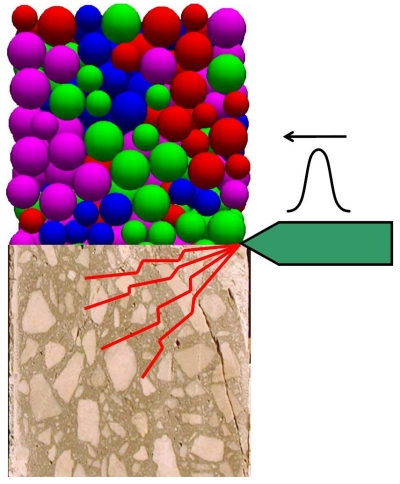Description
|
The Discrete Element Method (DEM) is used to investigate fracture phenomena in granular materials that are subjected to highly dynamic impact excitation. The resulting interaction of fracture and wave propagation is also considered. The granular material is modeled by introduction of breakable particle bonds in the DEM. This approach allows reproducing the strength and failure properties of geomaterials such as rock or concrete.
In the preceding project during the first funding period particle bonds were used, which act merely in normal direction of the relative particle motion and thus only carry tensile and compressive loadings. This particle bond is considered to break and removed from the simulation once an admissible load is exceeded. At first, it is investigated to which extend the simulation of failure of granular solids can be improved, if the particle bonds are extended to allow for failure upon shearing, bending and twisting.
In order to analyze the behaviour of breakable bodies with impact loading, the impact wave propagation in granular solids must be reproduced in the discrete element model. In particular, the influence of discretization and the implications of the different newly developed particle bonds are investigated with respect to impact wave propagation. It is also considered, how the impact wave is influenced by inhomogeneities in the material, and if dispersion effects are observed. Inhomogeneities may result from cracks or fractures.
Likewise, the inclusion of larger particles in a fine matrix represents material inhomogeneities, as for instance in concrete. Since the DEM particularly allows for the accurate representation of such inhomogeneities, it is expected that also the interaction of fracture phenomena and impact waves can be advantageously described with the DEM as compared to continuum methods such as the Finite Element Method. This project focuses also on the effects of pre-existing cracks or damage on wave propagation in DEM models. Therefore, it is intended to be able to correctly reproduce the mesoscopic failure mechanisms under highly dynamic, triaxial loading in the simulation. Within this context, long simulation times of some seconds with several 100,000 particles might be necessary.
It is also considered if fracture processes depend on propagating waves. The fracture processes might possibly be influenced by interference of waves. It has also to be established, if and to which extend strength and failure properties depend on the loading rate. The simulations have to provide an accurate description of mesoscopic failure mechanisms under multiaxial loading at high rates.
As an application example, the disintegration of rock or concrete by chiseling is considered. A realistic external excitation of fracture processes and impact waves in the granular material is obtained by coupling the DEM with an elastic multibody system in a co-simulation approach, see Figure 1. This allows for the simulation of the dynamics of an exciting power tool and its interaction with the granular solid. It is of particular importance, how the energy of waves propagating in the chisel can be transferred to the granular material. The repercussion of the break down of the granular material on the chisel is also considered.


